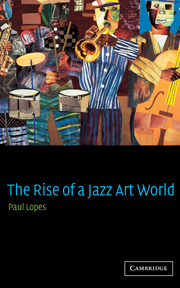Book contents
- Frontmatter
- Contents
- Acknowledgments
- Introduction: The quest for cultural legitimacy
- 1 Before the Jazz Age: professional musicians and good music
- 2 The Jazz Age: professional musicians and the cultivated vernacular
- 3 The swing craze: professional musicians, swing music, and the art of improvisation
- 4 The rise of a jazz art world: jazz enthusiasts, professional musicians, and the modernist revolt
- 5 The New Jazz Age: the jazz art world and the modern jazz renaissance
- Conclusion: The jazz art world and American culture
- Bibliography
- Index
5 - The New Jazz Age: the jazz art world and the modern jazz renaissance
Published online by Cambridge University Press: 22 September 2009
- Frontmatter
- Contents
- Acknowledgments
- Introduction: The quest for cultural legitimacy
- 1 Before the Jazz Age: professional musicians and good music
- 2 The Jazz Age: professional musicians and the cultivated vernacular
- 3 The swing craze: professional musicians, swing music, and the art of improvisation
- 4 The rise of a jazz art world: jazz enthusiasts, professional musicians, and the modernist revolt
- 5 The New Jazz Age: the jazz art world and the modern jazz renaissance
- Conclusion: The jazz art world and American culture
- Bibliography
- Index
Summary
It is true that no one human being can keep up with the Niagara of jazz recordings, concerts, and festivals, as well as radio, nightclub, and television appearances of jazz musicians … It wasn't always so. To the old-timer of the 20s, who remembers when a few grooves of a few 78-rpm recordings held all the recorded jazz extant, we are swinging through an era of plenty, a renaissance of jazz, which we will some day look back upon with wonder and envy. The sounds of jazz are hitting the public ear from all sides, and, although the conscientious critic necessarily finds that keeping up with it is difficult, in the midst of this great quantity of music, a new and qualitative change seems to be taking place.
Marshall Stearns, “What is Happening to Jazz,” Down Beat Music 1961, 1961: 28As a founding member of the United Hot Clubs of America in 1935, Marshall Stearns was selected by Down Beat in its annual review to reflect on the state of jazz during the 1950s. An avid follower of jazz since the late 1920s, Stearns pointed to a musical renaissance in jazz performance. He also noted the success of the jazz art world that sustained this renaissance in jazz music. In the 1950s, this art world began a period of rapid expansion in production, audiences, and stylistic innovation. It garnered national attention in print and broadcast media.
- Type
- Chapter
- Information
- The Rise of a Jazz Art World , pp. 217 - 268Publisher: Cambridge University PressPrint publication year: 2002



